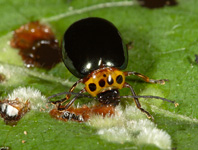Abstract
Recent elevation in the rank of J.E. Gray’s (1866) ‘Leaf-nosed Bats’ the Rhinonycterina to family level recognised the phylogenetic uniqueness of bats in the extant genera Cloeotis, Paratriaenops, Rhinonicteris and Triaenops, and the fossil genera Brachipposideros and Brevipalatus (Foley et al. 2015). In the systematic summary of that paper, attention was drawn to the issue of correct nomenclature because of past ambiguity around the appropriate spelling of the type genus Rhinonicteris (see also Simmons 2005; Armstrong 2006). However, no suggestion was made for the common name of the Rhinonycteridae, and that used for the Hipposideridae was simply duplicated—‘Old World Leaf-nosed Bats’. It would be helpful for this newly distinguished family to have its own appellation—to avoid unnecessary confusion in the wider literature, and to recognise its distinctiveness and evolutionary history.
References
Armstrong, K.N. (2006) Resolving the correct nomenclature of the orange leaf-nosed bat Rhinonicteris aurantia (Gray, 1845) (Hipposideridae). Australian Mammalogy, 28, 125–130.
http://dx.doi.org/10.1071/AM06020Benda, P. & Vallo, P. (2009) Taxonomic revision of the genus Triaenops (Chiroptera: Hipposideridae) with description of a new species from southern Arabia and definitions of a new genus and tribe. Folia Zoologica, 58, 1–45.
Benda, P., Vallo, P. & Reiter, A. (2011) Taxonomic revision of the genus Asellia (Chiroptera: Hipposideridae) with a description of a new species from Southern Arabia. Acta Chiropterologica, 13, 245–270.
http://dx.doi.org/10.3161/150811011X624749Foley, N.M., Thong, V.D., Soisook, P., Goodman, S.M., Armstrong, K.N., Jacobs, D., Peuchmaille, S.J. & Teeling, E.C. (2015) How and why overcome the impediments to resolution: lessons from rhinolophid and hipposiderid bats. Molecular Biology and Evolution, 32, 313–333.
http://dx.doi.org/10.1093/molbev/msu329Goodman, S.M. (2011) Les chauves-souris de Madagascar. Association Vahatra, Antananarivo, 129 pp.
Goodman, S.M. & Ranivo, J. (2009) The geographical origin of the type specimens of Triaenops rufus and T. humbloti (Chiroptera: Hipposideridae) reputed to be from Madagascar and the description of a replacement species name. Mammalia, 73, 47–55.
http://dx.doi.org/10.1515/MAMM.2009.011Gray, J.E. (1845) Description of some new Australian animals. In: Eyre, E.J. (Ed.), Journals of Expeditions of Discovery into Central Australia, and Overland from Adelaide to King George’s Sound, in the Years 1840–1; sent by the colonists of South Australia, with the sanction and support of the Government: including an account of the manners and customs of the Aborigines and the state of their relations with Europeans. T. and W. Boone, London, pp. 405–411, pls. 1–3.
http://dx.doi.org/10.1017/CBO9781139107464Gray, J.E. (1866) A revision of the genera of Rhinolophidae, or horseshoe bats. Proceedings of the Zoological Society of London, 1866, 81–83.
Hill, J. (1982) A review of the leaf-nosed bats Rhinonycteris, Cloeotis and Triaenops (Chiroptera: Hipposideridae). Bonner Zoologische Beiträge, 33, 165–186.
International Commission on Zoological Nomenclature (1999) International Code of Zoological Nomenclature: adopted by the International Union of Biological Sciences. 4th Edition. International Trust for Zoological Nomenclature, London, 335 pp.
IUCN (2016) The IUCN Red List of Threatened Species. Available from: http://www.icunredlist.org (accessed 13 September 2016)
Monadjem, A., Taylor, P.J., Cotterill, F.P.D. & Schoeman, M.C. (2010) Bats of southern and central Africa. A biogeographic and taxonomic synthesis. Wits University Press, Johannesburg, 596 pp.
Nowak, R.M. (1994) Walker’s bats of the world. Johns Hopkins University Press, Baltimore, 287 pp.
Simmons, N.B. (2005) Order Chiroptera. In: Wilson, D.E. & Reeder, D.M. (Eds.), Mammal species of the world: a taxonomic and geographic reference. 3rd Edition. Johns Hopkins University Press, Baltimore, pp. 312–529.
Tu, V.T., Csorba, G., Görföl, T., Arai, S., Son, N.T., Thanh, H.T. & Hassanin, A. (2015) Description of a new species of the genus Aselliscus (Chiroptera, Hipposideridae) from Vietnam. Acta Chiropterologica, 17, 233–254.
http://dx.doi.org/10.3161/15081109ACC2015.17.2.002Patterson, B.D. & Webala, P.W. (2012) Keys to the bats (Mammalia: Chiroptera) of East Africa. Fieldiana Life and Earth Sciences, 6, 1–60.
http://dx.doi.org/10.3158/2158-5520-12.6.1Wood Jones, F. (1923–1925) The mammals of South Australia. British Science Guild (South Australian Branch), Adelaide, 458 pp.

